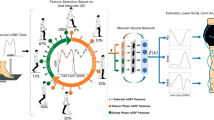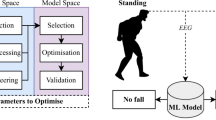Abstract
Wavelet neural networks (WNN) combine the strength of artificial neural networks and the multiresolution ability of wavelets. Determining the structure and, more specifically, the appropriate number of neurons in a WNN is a time-consuming process. We propose a type of multidimensional evolutionary WNN and, using an acrobot, evaluate this approach with two benchmark nonlinear control tasks: a height task and a hand-stand task. To facilitate direct comparison with other methods, we report on swing-up and balance times. In 50 trials, the controllers produced faster swing-up times—1.0 s for the best controller and 2.3 s on average—than any other methods reported in the literature. Moreover, the controller with the best swing-up time had a maximum balance time of 1.25 s, surpassing most other methods.











Similar content being viewed by others
References
Zhang J, Walter GG, Miao Y, Lee W (1995) Wavelet neural networks for function learning. IEEE Trans Signal Process 43(6):1485–1497
Vazquez LA, Jurado F, Alanis AY (2015) Decentralized identification and control in real-time of a robot manipulator via recurrent wavelet first-order neural network. Math Probl Eng 2015:1–12
Oysal Y, Yilmaz AS, Koklukaya E (2005) A dynamic wavelet network based adaptive load frequency control in power systems. Int J Electr Power Energy Syst 27(1):21–29
Zhong L (2010) Adaptive intelligent control of hydraulic generator unit based on wavelet networks. In: 2010 International conference on artificial intelligence and computational intelligence, vol 1, pp 107–110
Farahani M, Bidaki A, Enshaeieh M (2014) Intelligent control of a dc motor using a self-constructing wavelet neural network. Syst Sci Control Eng 2(1):261–267
Lin C, Tai C, Chung C (2014) Intelligent control system design for UAV using a recurrent wavelet neural network. Neural Comput Appl 24(2):487–496
Tian J, Gao M, Zhou H, Li J (2006) The intelligent control system of flocculation process of sewage treatment based on wavelet neural networks. In: Proceedings of the sixth international conference on intelligent systems design and applications (ISDA), vol 2. Washington, DC, USA, pp 219–224, IEEE Computer Society
Zhang Q, Benveniste A (1992) Wavelet networks. IEEE Trans Neural Netw 3(6):889–898
Szu H, Telfer B, Kadambe SL (1992) Neural network adaptive wavelets for signal representation and classification. Opt Eng 31(9):1907–1916
Yao S, Wei C, He Z (1995) Evolving wavelet neural networks. IEEE Int Conf Neural Netw 4:1851–1854
Prochazka A, Sys V (1994) Time series prediction using genetically trained wavelet networks. In: Proceedings of the IEEE workshop on neural networks for signal processing, pp 195–203
Cristea P, Tuduce R, Cristea A (2000) Time series prediction with wavelet neural networks. In: Proceedings of the 5th seminar on neural network applications in electrical engineering (NEUREL2000), pp 5–10
Yongyong H, Fulei C, Binglin Z (2002) A hierarchical evolutionary algorithm for constructing and training wavelet networks. Neural Comput Appl 10(4):357–366
Khan M, Chalup S, Mendes A (2014) Evolving wavelet neural networks for breast cancer classification. In: Twelfth Australasian data mining conference (AUSDM’2014), vol 158, pp 121–130
Alexandridis A, Zapranis A (2013) Wavelet neural networks: a practical guide. Neural Netw 42:1–27
Hsu C (2013) A self-evolving functional-linked wavelet neural network for control applications. Appl Soft Comput 13(11):4392–4402
Grefenstette J, Moriarty D, Schultz A (2011) Evolutionary algorithms for reinforcement learning, CoRR, vol arXiv:1106.0221
Whiteson S (2012) Evolutionary computation for reinforcement learning. Springer, Berlin, pp 325–355
Khan M, Khan G, Miller J (2010) Efficient representation of recurrent neural networks for markovian/non-markovian non-linear control problems. In: International conference on system design and applications (ISDA2010), pp 615–620
Gomez F, Schmidhuber J, Miikkulainen R (2006) Efficient non-linear control through neuroevolution. In: Proceedings of the 17th European conference on machine learning (ECML), Springer, Berlin, pp 654–662
Gomez F, Miikkulainen R (2002) Robust non-linear control through neuroevolution. tech. rep., Technical Report AI-TR-03-303, Artificial Intelligence Laboratory, The University of Texas at Austin
Moriarty DE (1997) Symbiotic evolution of neural networks in sequential decision tasks. Ph.D. thesis, Department of Computer Sciences, The University of Texas at Austin. Technical Report UT-AI97-257
Taylor M, Whiteson S, Stone P (2006) Comparing evolutionary and temporal difference methods for reinforcement learning. In: Proceedings of the genetic and evolutionary computation conference (GECCO2006), pp 1321–28, July
Schmidhuber J (2000) Evolutionary computation versus reinforcement learning. IEEE Int Conf Ind Electron Control Instrum 4:2992–2997
Spong MW (1994) Swing up control of the acrobot. IEEE Int Conf Robot Autom 3:2356–2361
Spong M (1995) The swing up control problem for the acrobot. IEEE Control Syst 15(1):49–55
Boone G (1997) Minimum-time control of the acrobot. Proc Int Conf Robot Autom 4:3281–3287
Sutton R (1996) Generalization in reinforcement learning: successful examples using sparse coarse coding. In: Advances in neural information processing systems (NIPS), vol 8, pp 1038–1044, MIT Press
Xu X, Hu D, Lu X (2007) Kernel-based least squares policy iteration for reinforcement learning. IEEE Trans Neural Netw 18(4):973–992
Doucette J, Heywood MI (2011) “Revisiting the acrobot ’height’ task: an example of efficient evolutionary policy search under an episodic goal seeking task. In: IEEE congress of evolutionary computation (CEC), pp 468–475
Neumann G, Peters JR (2009) Fitted q-iteration by advantage weighted regression. In: Koller D, Schuurmans D, Bengio Y, Bottou L (eds) Advances in neural information processing systems, vol 21, Curran Associates, Inc, pp 1177–1184
Duan Y, Chen X, Houthooft R, Schulman J, Abbeel P (2016) Benchmarking deep reinforcement learning for continuous control, CoRR, vol. arXiv:1604.06778
Wiklendt L, Chalup S, Middleton R (2009) A small spiking neural network with LQR control applied to the acrobot. Neural Comput Appl 18(4):369–375
Coulom R (2004) High-accuracy value-function approximation with neural networks. In: European symposium on artificial neural networks
DeJong G, Spong MW (1994) Swinging up the acrobot: an example of intelligent control. In: American control conference, 1994, vol 2, pp 2158–2162
Jung T, Polani D, Stone P (2011) Empowerment for continuous agent-environment systems. Adapt Behav 19(1):16–39
Munos R, Moore A (1999) Variable resolution discretization for high-accuracy solutions of optimal control problems. In: Proceedings of the 16th international joint conference on artificial intelligence (IJCAI), vol 2, pp 1348–1355
Duong SC, Kinjo H, Uezato E, Yamamoto T (2009) On the continuous control of the acrobot via computational intelligence. In: International conference on industrial, engineering and other applications of applied intelligent systems: next-generation applied intelligence, Springer, Berlin, pp 231–241
Dracopoulos D, Nichols B (2015) Genetic programming for the minimum time swing up and balance control acrobot problem. Expert Syst 34(5):1–9
Yoshimoto J, Ishii S, Sato M (1999) Application of reinforcement learning to balancing of acrobot. In: IEEE International conference on systems, man and cybernetics (SMC), vol 5, pp 516–521
Yoshimoto J, Nishimura M, Tokita Y, Ishii S (2005) Acrobot control by learning the switching of multiple controllers. Artif Life Robot 9(2):67–71
Oussar Y, Dreyfus G (2000) Initialization by selection for wavelet network training. Neurocomputing 34:131–143
Khan M, Khan G, Ahmad A, Miller J (2013) Fast learning neural networks using cartesian genetic programming. Neurocomputing 121:274–289
Mnih V, Kavukcuoglu K, Silver D, Graves A, Antonoglou I, Wierstra D, Riedmiller MA (2013) Playing atari with deep reinforcement learning, CoRR, vol. arXiv:1312.5602
Acknowledgements
The first author would like to acknowledge the support through an Australian Government Research Training Program Scholarship.
Author information
Authors and Affiliations
Corresponding author
Additional information
Publisher's Note
Springer Nature remains neutral with regard to jurisdictional claims in published maps and institutional affiliations.
Rights and permissions
About this article
Cite this article
Khan, M.M., Mendes, A. & Chalup, S.K. Performance of evolutionary wavelet neural networks in acrobot control tasks. Neural Comput & Applic 32, 8493–8505 (2020). https://doi.org/10.1007/s00521-019-04347-x
Received:
Accepted:
Published:
Issue Date:
DOI: https://doi.org/10.1007/s00521-019-04347-x




